Influence of Changing Weather on Old and New Maize Hybrids: A Case Study in Romania
Abstract
:1. Introduction
2. Results
2.1. Variation in the Climatic Conditions of the Experimental Years
2.2. Reaction of Hybrids at BBCH65
2.3. The Yield Obtained in the Conditions of the Experimental Years
3. Discussion
3.1. Drought and Heat Effect on Maize
3.2. Old vs. New Hybrids
3.3. Future Prospects
4. Materials and Methods
4.1. Biological Material
4.2. Cultivation Technology and Experimental Design
4.3. Meteorological Data
4.4. Data Analysis
5. Conclusions
Supplementary Materials
Author Contributions
Funding
Data Availability Statement
Acknowledgments
Conflicts of Interest
References
- Sheoran, S.; Kaur, Y.; Kumar, S.; Shukla, S.; Rakshit, S.; Kumar, R. Recent Advances for Drought Stress Tolerance in Maize (Zea mays L.): Present Status and Future Prospects. Front. Plant Sci. 2022, 13, 872566. [Google Scholar] [CrossRef] [PubMed]
- FAOSTAT. Available online: https://www.fao.org/faostat/en/#data/ET/visualize (accessed on 10 January 2024).
- Spinoni, J.; Barbosa, P.; De Jager, A.; McCormick, N.; Naumann, G.; Vogt, J.V.; Magni, D.; Masante, D.; Mazzeschi, M. A New Global Database of Meteorological Drought Events from 1951 to 2016. J. Hydrol. Reg. Stud. 2019, 22, 100593. [Google Scholar] [CrossRef]
- EDO Home—European Drought Observatory—JRC European Commission. Available online: https://edo.jrc.ec.europa.eu/edov2/php/index.php?id=1000 (accessed on 10 January 2024).
- Meteo Romania|The Website of the National Meteorological Administration. Available online: https://www.meteoromania.ro/ (accessed on 29 July 2024).
- Ciornei, L.; Udrea, L.; Munteanu, P.; Simion, P.-S.; Petcu, V. The Effects of Climate Change. Trends Regarding the Evolution of Temperature in Romania. Ann. Valahia Univ. Targoviste Agric. 2023, 15, 50–57. [Google Scholar] [CrossRef]
- Partal, E.; Oltenacu, C.V.; Petcu, V. The Influence of Sowing Date and Plant Density on Maize Yield and Quality in the Context of Climate Change in Southern Romania. Sci. Pap. Ser. A Agron. 2021, 64, 508–514. [Google Scholar]
- Vorovencii, I. Assessing and Monitoring the Risk of Desertification in Dobrogea, Romania, Using Landsat Data and Decision Tree Classifier. Environ. Monit. Assess. 2015, 187, 204. [Google Scholar] [CrossRef] [PubMed]
- Dumitraşcu, M.; Mocanu, I.; Mitrică, B.; Dragotă, C.; Grigorescu, I.; Dumitrică, C. The Assessment of Socio-Economic Vulnerability to Drought in Southern Romania (Oltenia Plain). Int. J. Disaster Risk Reduct. 2018, 27, 142–154. [Google Scholar] [CrossRef]
- Angearu, C.-V.; Ontel, I.; Boldeanu, G.; Mihailescu, D.; Nertan, A.; Craciunescu, V.; Catana, S.; Irimescu, A. Multi-Temporal Analysis and Trends of the Drought Based on MODIS Data in Agricultural Areas, Romania. Remote Sens. 2020, 12, 3940. [Google Scholar] [CrossRef]
- Ontel, I.; Cheval, S.; Irimescu, A.; Boldeanu, G.; Amihaesei, V.-A.; Mihailescu, D.; Nertan, A.; Angearu, C.-V.; Craciunescu, V. Assessing the Recent Trends of Land Degradation and Desertification in Romania Using Remote Sensing Indicators. Remote Sens. 2023, 15, 4842. [Google Scholar] [CrossRef]
- Bran, V.; Ustinescu, G. Reflections on the Phenomenon of Desertification and Its Influence on the Natural Ecosystems in Romania. Ovidius Univ. Ann. Econ. Sci. Ser. 2018, 18, 133–138. [Google Scholar]
- Secu, C.V.; Stoleriu, C.C.; Lesenciuc, C.D.; Ursu, A. Normalized Sand Index for Identification of Bare Sand Areas in Temperate Climates Using Landsat Images, Application to the South of Romania. Remote Sens. 2022, 14, 3802. [Google Scholar] [CrossRef]
- Bordun, C.; Cimpeanu, S.M. Remote Sensing for Desertification Monitoring in Braila County. Sci. Pap. Ser. E Land Reclam. Earth Obs. Surv. Environ. Eng. 2017, 6, 163–168. [Google Scholar]
- Croitoru, A.-E.; Piticar, A.; Ciupertea, A.-F.; Roşca, C.F. Changes in Heat Waves Indices in Romania over the Period 1961–2015. Glob. Planet. Chang. 2016, 146, 109–121. [Google Scholar] [CrossRef]
- Herbel, I.; Croitoru, A.-E.; Rus, A.V.; Roşca, C.F.; Harpa, G.V.; Ciupertea, A.-F.; Rus, I. The Impact of Heat Waves on Surface Urban Heat Island and Local Economy in Cluj-Napoca City, Romania. Theor. Appl. Clim. 2018, 133, 681–695. [Google Scholar] [CrossRef]
- Piticar, A.; Croitoru, A.-E.; Ciupertea, F.-A.; Harpa, G.-V. Recent Changes in Heat Waves and Cold Waves Detected Based on Excess Heat Factor and Excess Cold Factor in Romania. Int. J. Climatol. 2018, 38, 1777–1793. [Google Scholar] [CrossRef]
- Nagavciuc, V.; Scholz, P.; Ionita, M. Hotspots for Warm and Dry Summers in Romania. Nat. Hazards Earth Syst. Sci. 2022, 22, 1347–1369. [Google Scholar] [CrossRef]
- Minea, I.; Iosub, M.; Boicu, D. Multi-Scale Approach for Different Type of Drought in Temperate Climatic Conditions. Nat. Hazards 2022, 110, 1153–1177. [Google Scholar] [CrossRef]
- Minea, I.; Iosub, M.; Boicu, D. Groundwater Resources from Eastern Romania under Human and Climatic Pressure. Sustainability 2020, 12, 10341. [Google Scholar] [CrossRef]
- Sánchez, B.; Rasmussen, A.; Porter, J.R. Temperatures and the Growth and Development of Maize and Rice: A Review. Glob. Chang. Biol. 2014, 20, 408–417. [Google Scholar] [CrossRef]
- Wang, J.; Vanga, S.K.; Saxena, R.; Orsat, V.; Raghavan, V. Effect of Climate Change on the Yield of Cereal Crops: A Review. Climate 2018, 6, 41. [Google Scholar] [CrossRef]
- Meseka, S.; Menkir, A.; Bossey, B.; Mengesha, W. Performance Assessment of Drought Tolerant Maize Hybrids under Combined Drought and Heat Stress. Agronomy 2018, 8, 274. [Google Scholar] [CrossRef]
- Nasser, L.M.; Badu-Apraku, B.; Gracen, V.E.; Mafouasson, H.N.A. Combining Ability of Early-Maturing Yellow Maize Inbreds under Combined Drought and Heat Stress and Well-Watered Environments. Agronomy 2020, 10, 1585. [Google Scholar] [CrossRef]
- Cairns, J.E.; Crossa, J.; Zaidi, P.H.; Grudloyma, P.; Sanchez, C.; Araus, J.L.; Thaitad, S.; Makumbi, D.; Magorokosho, C.; Bänziger, M.; et al. Identification of Drought, Heat, and Combined Drought and Heat Tolerant Donors in Maize. Crop Sci. 2013, 53, 1335–1346. [Google Scholar] [CrossRef]
- Niu, S.; Du, X.; Wei, D.; Liu, S.; Tang, Q.; Bian, D.; Zhang, Y.; Cui, Y.; Gao, Z. Heat Stress After Pollination Reduces Kernel Number in Maize by Insufficient Assimilates. Front. Genet. 2021, 12, 728166. [Google Scholar] [CrossRef] [PubMed]
- Benchikh-Lehocine, M.; Revilla, P.; Malvar, R.A.; Djemel, A. Response to Selection for Reduced Anthesis-Silking Interval in Four Algerian Maize Populations. Agronomy 2021, 11, 382. [Google Scholar] [CrossRef]
- Javed, N.; Ashraf, M.; Akram, N.A.; Al-Qurainy, F. Alleviation of Adverse Effects of Drought Stress on Growth and Some Potential Physiological Attributes in Maize (Zea mays L.) by Seed Electromagnetic Treatment. Photochem. Photobiol. 2011, 87, 1354–1362. [Google Scholar] [CrossRef]
- Daryanto, S.; Wang, L.; Jacinthe, P.-A. Global Synthesis of Drought Effects on Maize and Wheat Production. PLoS ONE 2016, 11, e0156362. [Google Scholar] [CrossRef]
- Rasheed, A.; Jie, H.; Ali, B.; He, P.; Zhao, L.; Ma, Y.; Xing, H.; Qari, S.H.; Hassan, M.U.; Hamid, M.R.; et al. Breeding Drought-Tolerant Maize (Zea mays) Using Molecular Breeding Tools: Recent Advancements and Future Prospective. Agronomy 2023, 13, 1459. [Google Scholar] [CrossRef]
- Loro, M.V.; Carvalho, I.R.; Pradebon, L.C.; Sangiovo, J.P.; Roza, J.P.D.; Zuse, G.H.; Foleto, E.E. Maize Genetic Breeding for Tolerance to Abiotic Stress with Focus on Sustainable Use of Environmental Resources. Agron. Sci. Biotechnol. 2024, 10, 1–12. [Google Scholar] [CrossRef]
- Mukaro, R.; Kamutando, C.N.; Magorokosho, C.; Mutari, B.; Zaidi, P.H.; Kutywayo, D.; Sibiya, J. Genetic Potential of Tropically Adapted Exotic Maize (Zea mays L.) Heat-Tolerant Donor Lines in Sub-Tropical Breeding Programs. Agronomy 2023, 13, 2050. [Google Scholar] [CrossRef]
- Debesa, B.; Ayalneh, D.; Habtemariam, E.; Mitiku, T.; Wendwesson, T.; Nur, S.; Getachew, T.; Mitiku, A.; Yadessa, L. Review on Breeding Strategies for Drought Tolerance in Maize (Zea mays L.). Am. J. Plant Sci. 2023, 11, 1858. [Google Scholar]
- Simon, A. Caracterizarea Climatică a Lunilor Iunie Și Iulie Din Ultimul Deceniu Pentru Zona Turda. Agric. Transilv. 2022, 37, 9–14. [Google Scholar]
- Yang, X.; Asseng, S.; Wong, M.T.F.; Yu, Q.; Li, J.; Liu, E. Quantifying the Interactive Impacts of Global Dimming and Warming on Wheat Yield and Water Use in China. Agric. For. Meteorol. 2013, 182–183, 342–351. [Google Scholar] [CrossRef]
- Chen, C.; Wang, E.; Yu, Q.; Zhang, Y. Quantifying the Effects of Climate Trends in the Past 43 Years (1961–2003) on Crop Growth and Water Demand in the North China Plain. Clim. Chang. 2010, 100, 559–578. [Google Scholar] [CrossRef]
- Song, L.; Jin, J. Effects of Sunshine Hours and Daily Maximum Temperature Declines and Cultivar Replacements on Maize Growth and Yields. Agronomy 2020, 10, 1862. [Google Scholar] [CrossRef]
- Zongxing, L.; Qi, F.; Wei, Z.; Yuanqing, H.; Xufeng, W.; Catto, N.; Wenlin, A.; Jiankuo, D.; Aifang, C.; Li, L.; et al. Decreasing Trend of Sunshine Hours and Related Driving Forces in Southwestern China. Theor. Appl. Clim. 2012, 109, 305–321. [Google Scholar] [CrossRef]
- van den Besselaar, E.J.M.; Sanchez-Lorenzo, A.; Wild, M.; Klein Tank, A.M.G.; de Laat, A.T.J. Relationship between Sunshine Duration and Temperature Trends across Europe since the Second Half of the Twentieth Century. J. Geophys. Res. Atmos. 2015, 120, 10823–10836. [Google Scholar] [CrossRef]
- Wild, M. Enlightening Global Dimming and Brightening. Bull. Am. Meteorol. Soc. 2012, 93, 27–37. [Google Scholar] [CrossRef]
- Căbulea, I. Genetica Porumbului. In Porumbul—Studiu Monografic; Editura Academiei Române: București, Romania, 2004; Volume 1, pp. 207–310. ISBN 973-27-1056-X. [Google Scholar]
- Varga, A.; Haș, V.; Tritean, N.; Vana, C.; Călugăr, R.; Mureșanu, F.; Șopterean, L. Mid-Early new generation hybrid Turda 380 adapted to climate change in the center of the country. Analele INCDA Fundulea 2022, 90, 63–71. [Google Scholar]
- Haș, V.; Copândean, A.; Tritean, N.; Varga, A.; Vana, C.; Călugăr, R.; Mureșanu, F.; Șopterean, L. Noi realizări în domeniul ameliorării porumbului la S.C.D.A. Turda. Analele INCDA Fundulea 2021, 89, 49–61. [Google Scholar]
- Haş, V.; Copândean, A.; Varga, A.; Vana, C.; Călugăr, R.; Mureşanu, F. Maize hybrid “Turda 344”. Analele INCDA Fundulea 2018, 86, 85–95. [Google Scholar]
- Vana, C.D.; Varga, A.; Călugăr, R.-E.; Ceclan, L.A.; Popa, C.; Șopterean, L.; Tritean, N.; Russu, F. The Reaction of Some Maize Hybrids to Several Plant Densities, in the Cultivation Conditions of Central Northwest Part of Romania. Rom. Agric. Res. 2024, 41, 91–98. [Google Scholar] [CrossRef]
- Fahad, S.; Bajwa, A.A.; Nazir, U.; Anjum, S.A.; Farooq, A.; Zohaib, A.; Sadia, S.; Nasim, W.; Adkins, S.; Saud, S.; et al. Crop Production under Drought and Heat Stress: Plant Responses and Management Options. Front. Plant Sci. 2017, 8, 1147. [Google Scholar] [CrossRef] [PubMed]
- Sah, R.P.; Chakraborty, M.; Prasad, K.; Pandit, M.; Tudu, V.K.; Chakravarty, M.K.; Narayan, S.C.; Rana, M.; Moharana, D. Impact of Water Deficit Stress in Maize: Phenology and Yield Components. Sci. Rep. 2020, 10, 2944. [Google Scholar] [CrossRef]
- Wang, L.; Yan, Y.; Lu, W.; Lu, D. Application of Exogenous Phytohormones at Silking Stage Improve Grain Quality under Post-Silking Drought Stress in Waxy Maize. Plants 2021, 10, 48. [Google Scholar] [CrossRef]
- Kim, K.-H.; Lee, B.-M. Effects of Climate Change and Drought Tolerance on Maize Growth. Plants 2023, 12, 3548. [Google Scholar] [CrossRef]
- Edmeades, G.O.; Bolaños, J.; Hernàndez, M.; Bello, S. Causes for Silk Delay in a Lowland Tropical Maize Population. Crop Sci. 1993, 33, 1029–1035. [Google Scholar] [CrossRef]
- Vâtcă, S.D.; Stoian, V.A.; Man, T.C.; Horvath, C.; Vidican, R.; Gâdea, S.; Vâtcă, A.; Rotaru, A.; Vârban, R.; Moldovan, C.; et al. Agrometeorological Requirements of Maize Crop Phenology for Sustainable Cropping—A Historical Review for Romania. Sustainability 2021, 13, 7719. [Google Scholar] [CrossRef]
- Silva, P.C.; Sánchez, A.C.; Opazo, M.A.; Mardones, L.A.; Acevedo, E.A. Grain Yield, Anthesis-Silking Interval, and Phenotypic Plasticity in Response to Changing Environments: Evaluation in Temperate Maize Hybrids. Field Crops Res. 2022, 285, 108583. [Google Scholar] [CrossRef]
- Drought and Heat Stress Effects on Corn Pollination (Purdue). Available online: https://www.agry.purdue.edu/ext/corn/pubs/corn-07.htm (accessed on 2 July 2024).
- Abdelgawad, Z.A.; Khalafaallah, A.A.; Abdallah, M.M. Impact of Methyl Jasmonate on Antioxidant Activity and Some Biochemical Aspects of Maize Plant Grown under Water Stress Condition. Agric. Sci. 2014, 5, 1077–1088. [Google Scholar] [CrossRef]
- Some Droughty Fields Experiencing Silk Emergence Delay (Purdue Univ.). Available online: https://www.agry.purdue.edu/ext/corn/news/articles.02/SilkDelay-0726.html (accessed on 2 July 2024).
- Grant, R.F.; Jackson, B.S.; Kiniry, J.R.; Arkin, G.F. Water Deficit Timing Effects on Yield Components in Maize. Agron. J. 1989, 81, 61–65. [Google Scholar] [CrossRef]
- NeSmith, D.S.; Ritchie, J.T. Effects of Soil Water-Deficits during Tassel Emergence on Development and Yield Component of Maize (Zea mays). Field Crops Res. 1992, 28, 251–256. [Google Scholar] [CrossRef]
- Herrero, M.P.; Johnson, R.R. Drought Stress and Its Effects on Maize Reproductive Systems. Crop Sci. 1981, 21, 105–110. [Google Scholar] [CrossRef]
- Carter, E.K.; Melkonian, J.; Riha, S.J.; Shaw, S.B. Separating Heat Stress from Moisture Stress: Analyzing Yield Response to High Temperature in Irrigated Maize. Environ. Res. Lett. 2016, 11, 094012. [Google Scholar] [CrossRef]
- Chetan, F.; Dulf, E.-H.; Rusu, T.; Chetan, C.; Simon, A. Temperature and Precipitation Forecast for Western Transylvanian Plains Using Artificial Intelligence. AgroLife Sci. J. 2024, 13, 41–53. [Google Scholar] [CrossRef]
- Barker, T.; Campos, H.; Cooper, M.; Dolan, D.; Edmeades, G.; Habben, J.; Schussler, J.; Wright, D.; Zinselmeier, C. Improving Drought Tolerance in Maize. In Plant Breeding Reviews; John Wiley & Sons, Ltd.: Hoboken, NJ, USA, 2005; pp. 173–253. ISBN 978-0-470-65030-1. [Google Scholar]
- Stress, Anthesis—Silk Interval and Corn Yield Potential|Integrated Crop Management. Available online: https://crops.extension.iastate.edu/cropnews/2012/07/stress-anthesis-silk-interval-and-corn-yield-potential (accessed on 2 July 2024).
- Bonea, D.; Urechean, V. Response of Maize Yield to Variation in Rainfall and Average Temperature in Central Part of Oltenia. Rom. Agric. Res. 2020, 37, 41–48. [Google Scholar] [CrossRef]
- Dunăreanu, I.C.; Bonea, D. Comparative Performance and Stability of Some Maize Hybrids in the Agroclimatic Conditions of Craiova, Dolj County, Romania. Sci. Pap. Ser. Manag. Econ. Eng. Agric. Rural Dev. 2022, 22, 203–210. [Google Scholar]
- Vlăduț, A.Ș.; Licurici, M.; Burada, C.D. Influence of Climate Conditions on Maize Yield in Oltenia (1990–2021). Forum Geogr. 2023, XXII, 125–143. [Google Scholar] [CrossRef]
- Horablaga, M.N.; Imbrea, I.M.; Horablaga, A.; Imbrea, F. Study of Agronomic Characteristics of Some Corn Lines Created at Scda Lovrin. Sci. Pap. Ser. A Agron. 2023, 66, 251–263. [Google Scholar]
- Horablaga, M.N.; Chis, C.; Bătrîna, Ș.L.; Alina, I.; Imbrea, I.M.; Horablaga, A.; Imbrea, F. Analysis of the Agronomic Traits of 15 Maize Hybrids Cultivated in the Western Part of Romania. Sci. Pap. Ser. A Agron. 2023, 66, 349–357. [Google Scholar]
- Molla, S.H.; Nakasathien, S.; Sarobol, E.; Vichukit, V. Anthesis and Silking Dynamics of Maize under Contrasting Nitrogen and Water Levels. Kasetsart J. Nat. Sci. 2014, 48, 837–850. [Google Scholar]
- dos Santos, T.B.; Ribas, A.F.; de Souza, S.G.H.; Budzinski, I.G.F.; Domingues, D.S. Physiological Responses to Drought, Salinity, and Heat Stress in Plants: A Review. Stresses 2022, 2, 113–135. [Google Scholar] [CrossRef]
- Frantová, N.; Rábek, M.; Porčová, L.; Jovanović, I.; Širůček, P.; Lukas, V.; Hájek, J.; Elzner, P.; Holková, L.; Smutná, P.; et al. Monitoring Drought Tolerance Mechanisms of Sorghum and Maize Under Unevenly Distributed Precipitation. Int. J. Plant Prod. 2024, 18, 49–67. [Google Scholar] [CrossRef]
- Liu, S.; Qin, F. Genetic Dissection of Maize Drought Tolerance for Trait Improvement. Mol. Breed. 2021, 41, 8. [Google Scholar] [CrossRef] [PubMed]
- Zepner, L.; Karrasch, P.; Wiemann, F.; Bernard, L. ClimateCharts.Net—An Interactive Climate Analysis Web Platform. Int. J. Digit. Earth 2020, 14, 338–356. [Google Scholar] [CrossRef]
- Eberhart, S.A.; Russell, W.A. Stability Parameters for Comparing Varieties1. Crop Sci. 1966, 6, 36–40. [Google Scholar] [CrossRef]
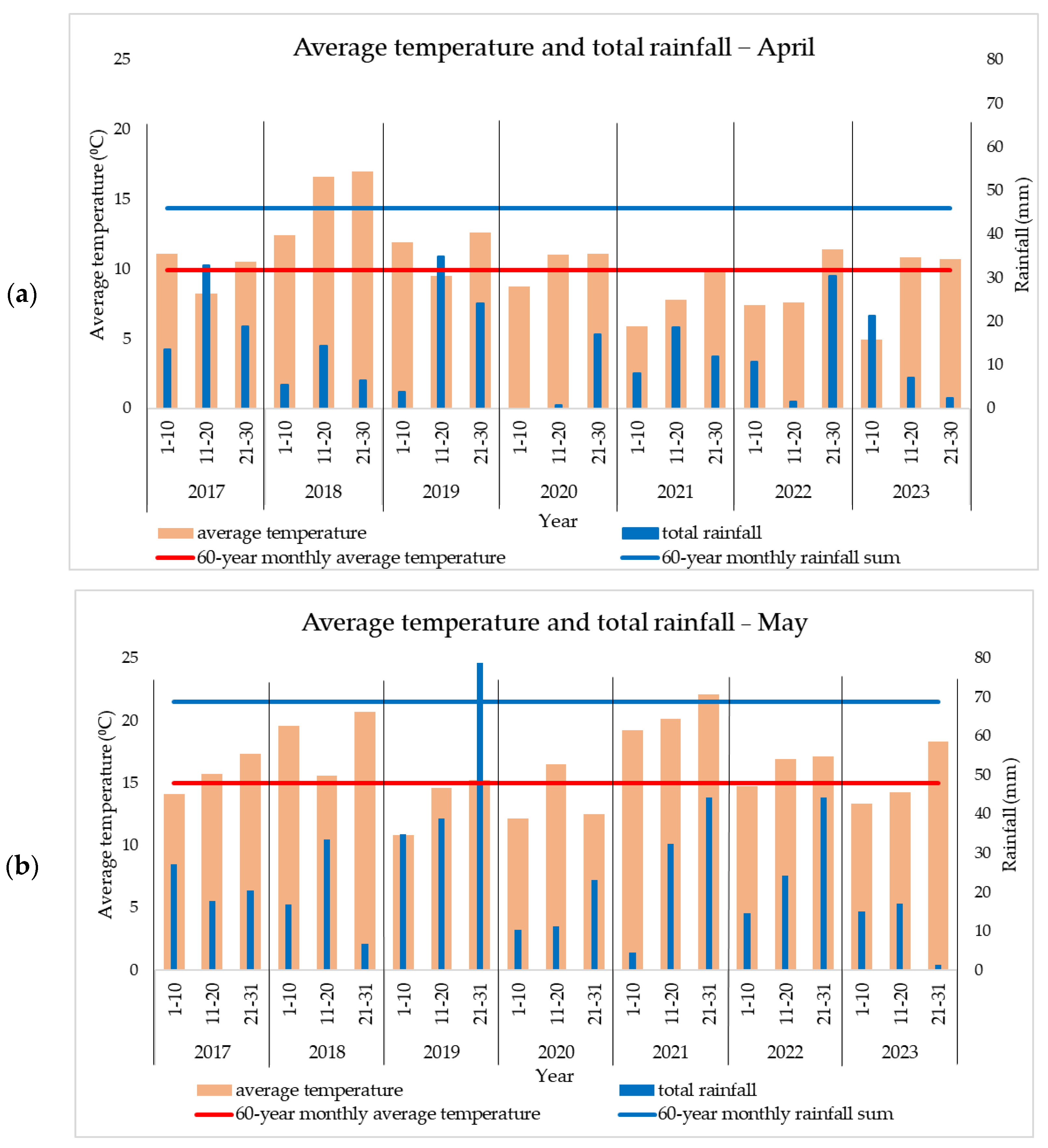
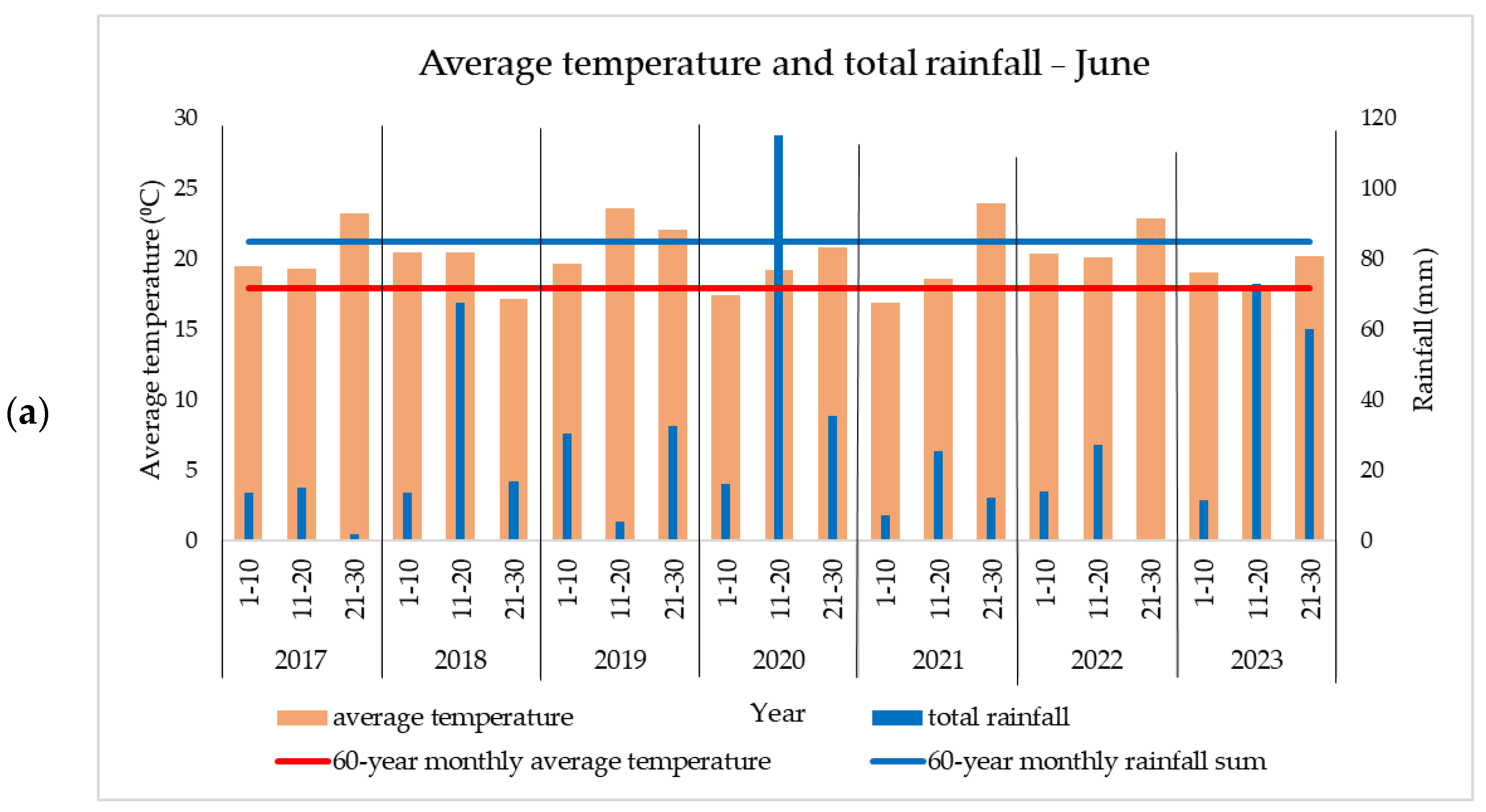
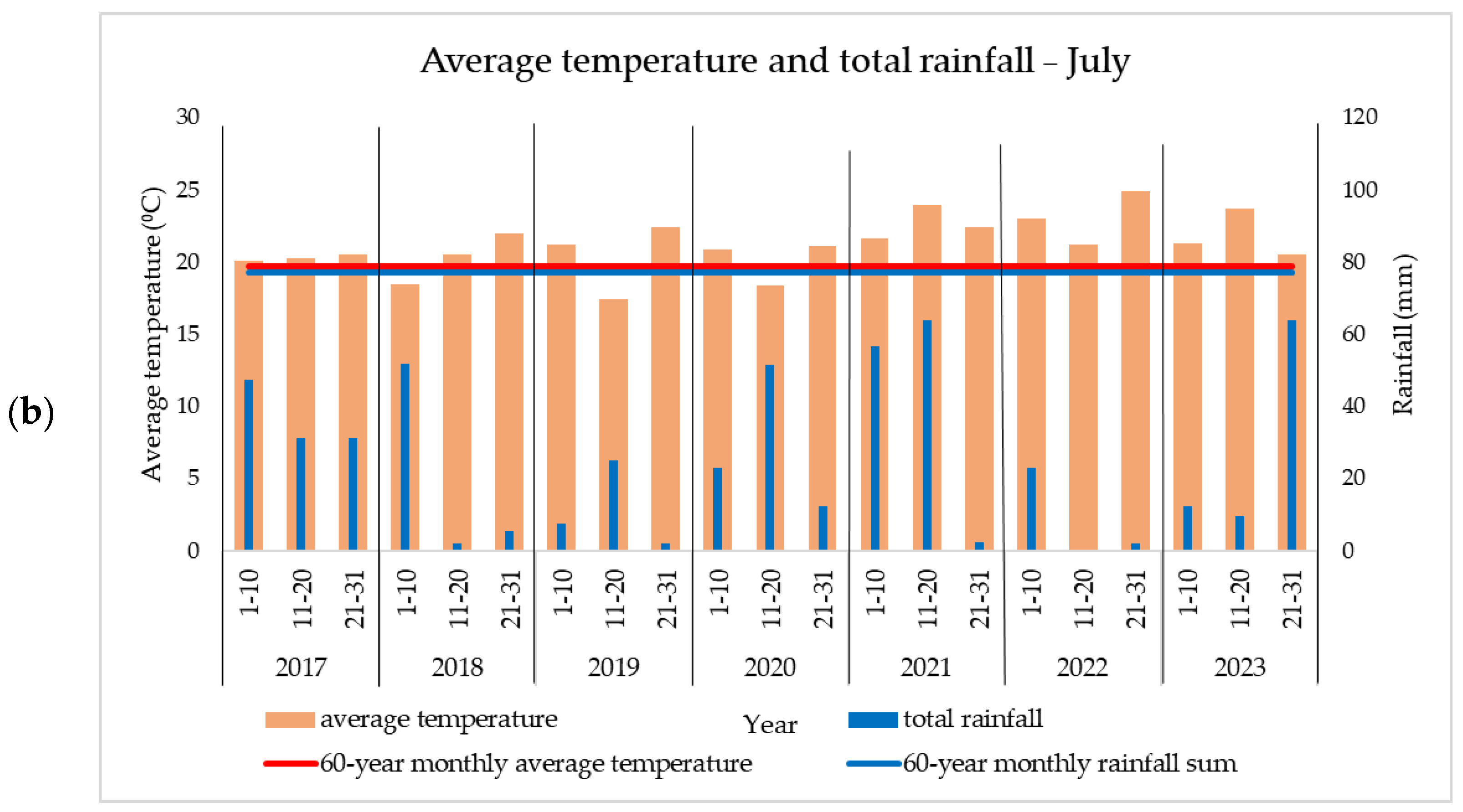
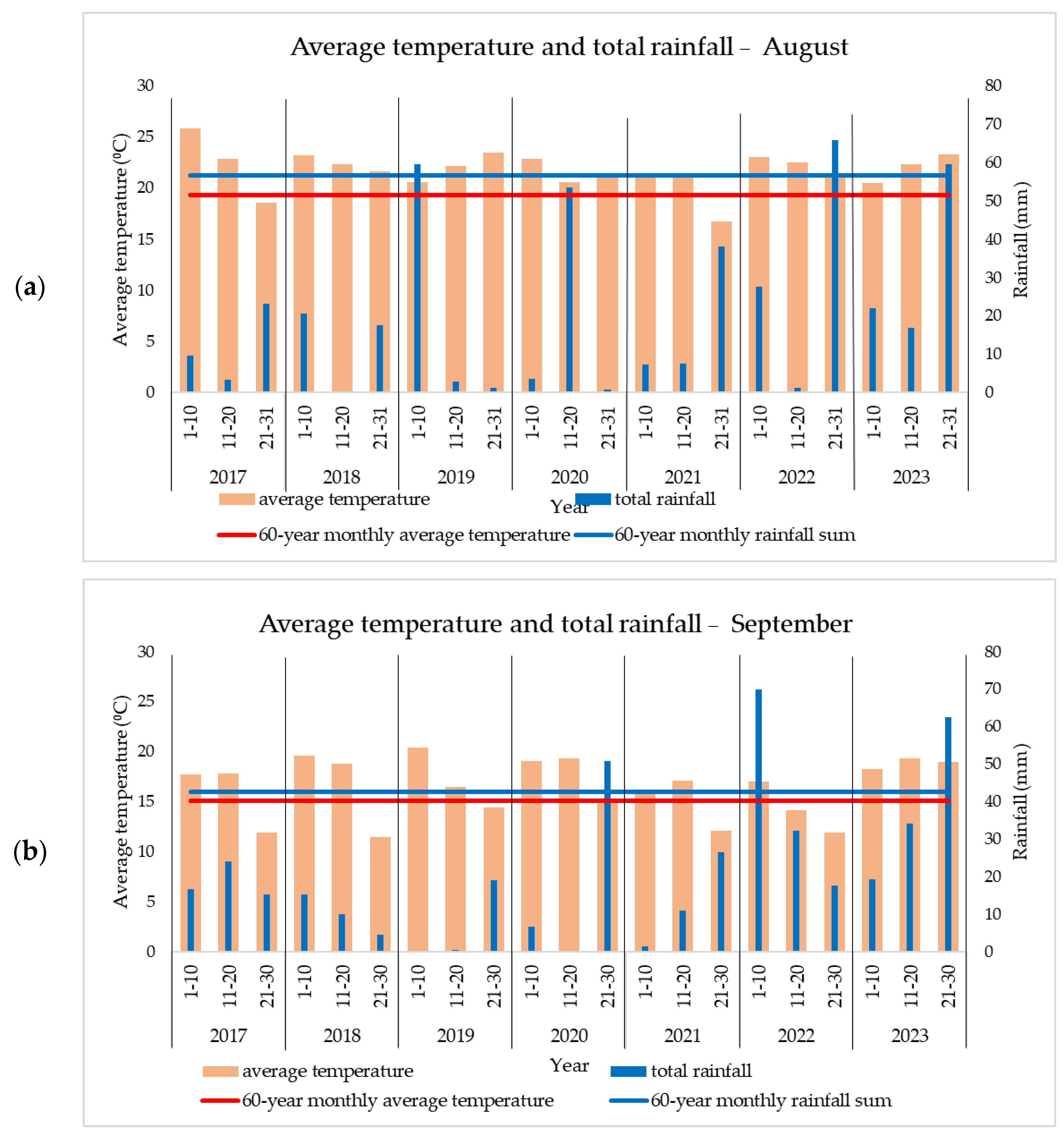
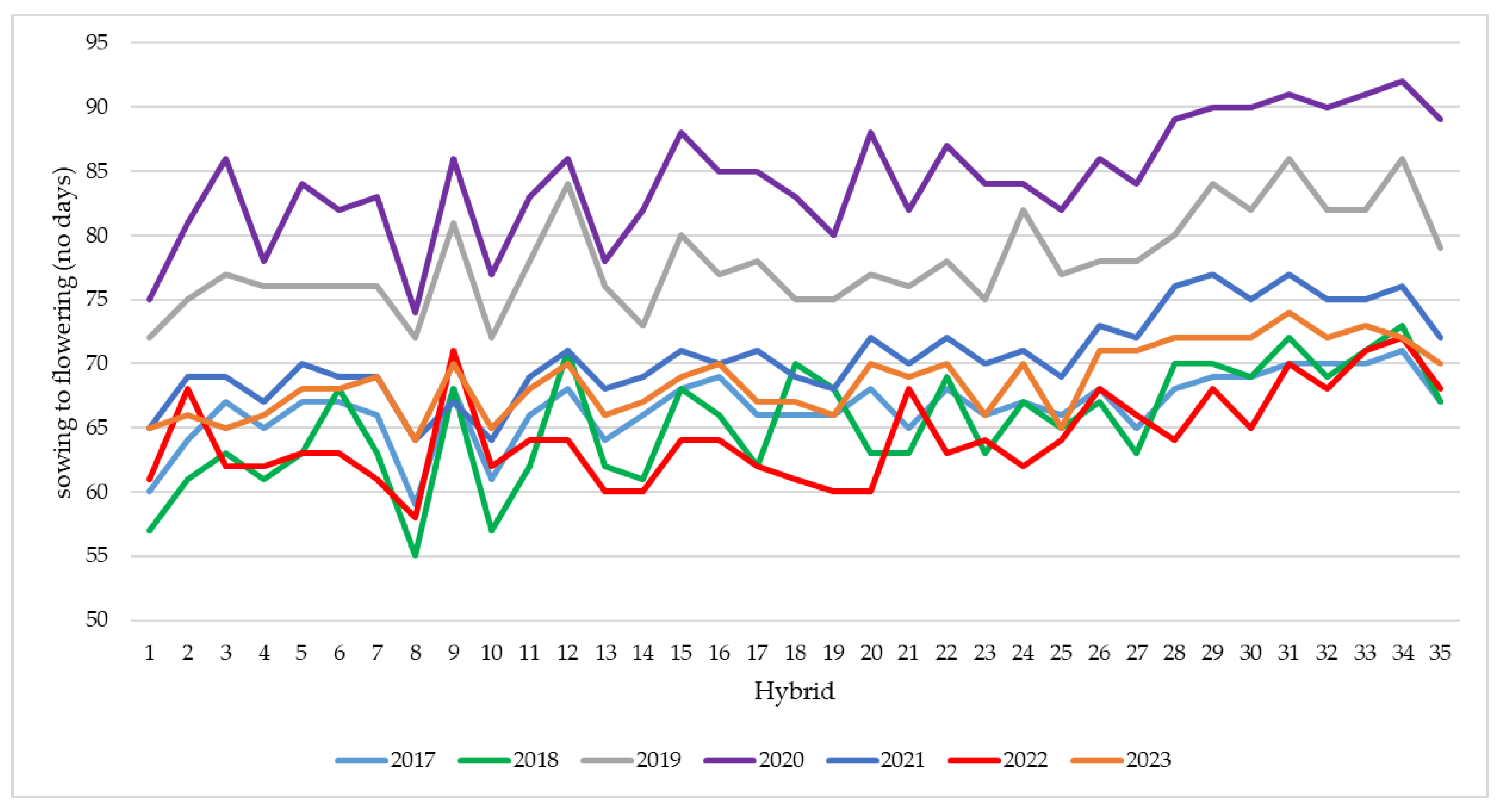
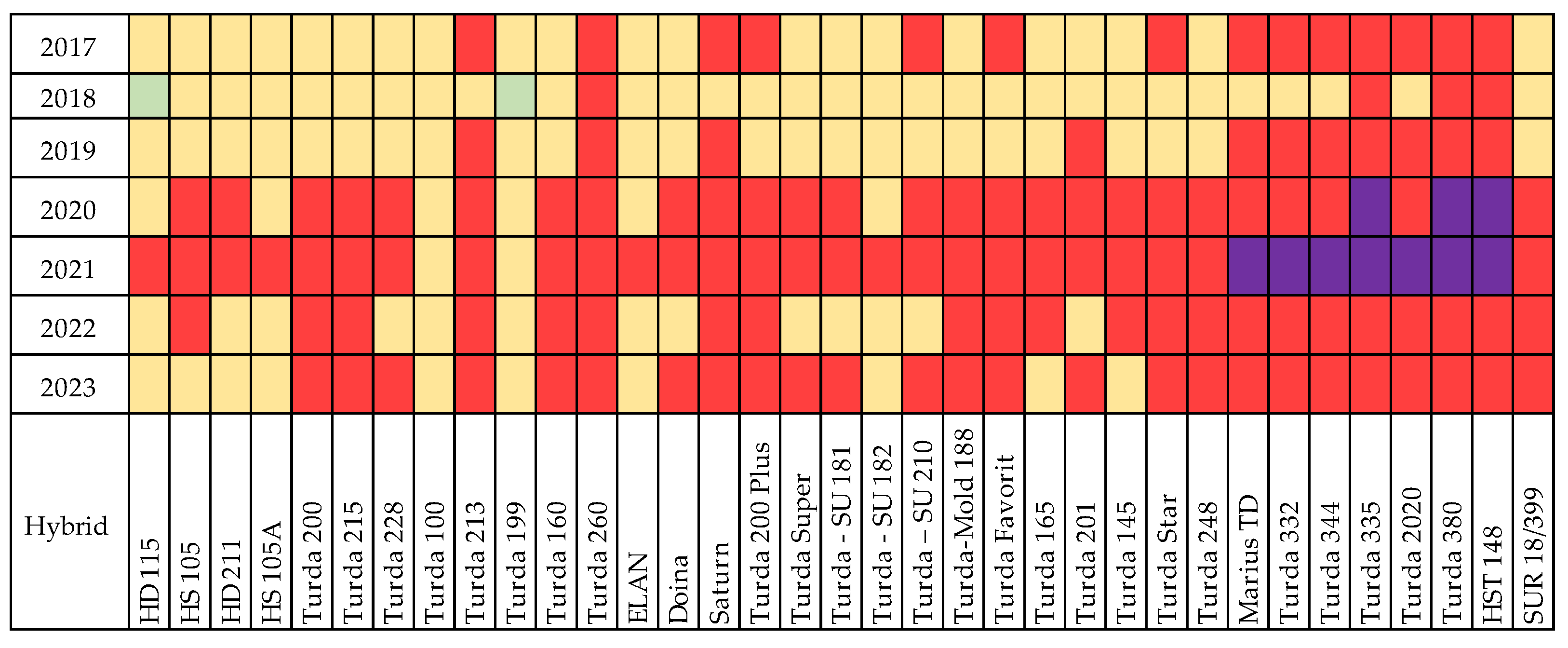
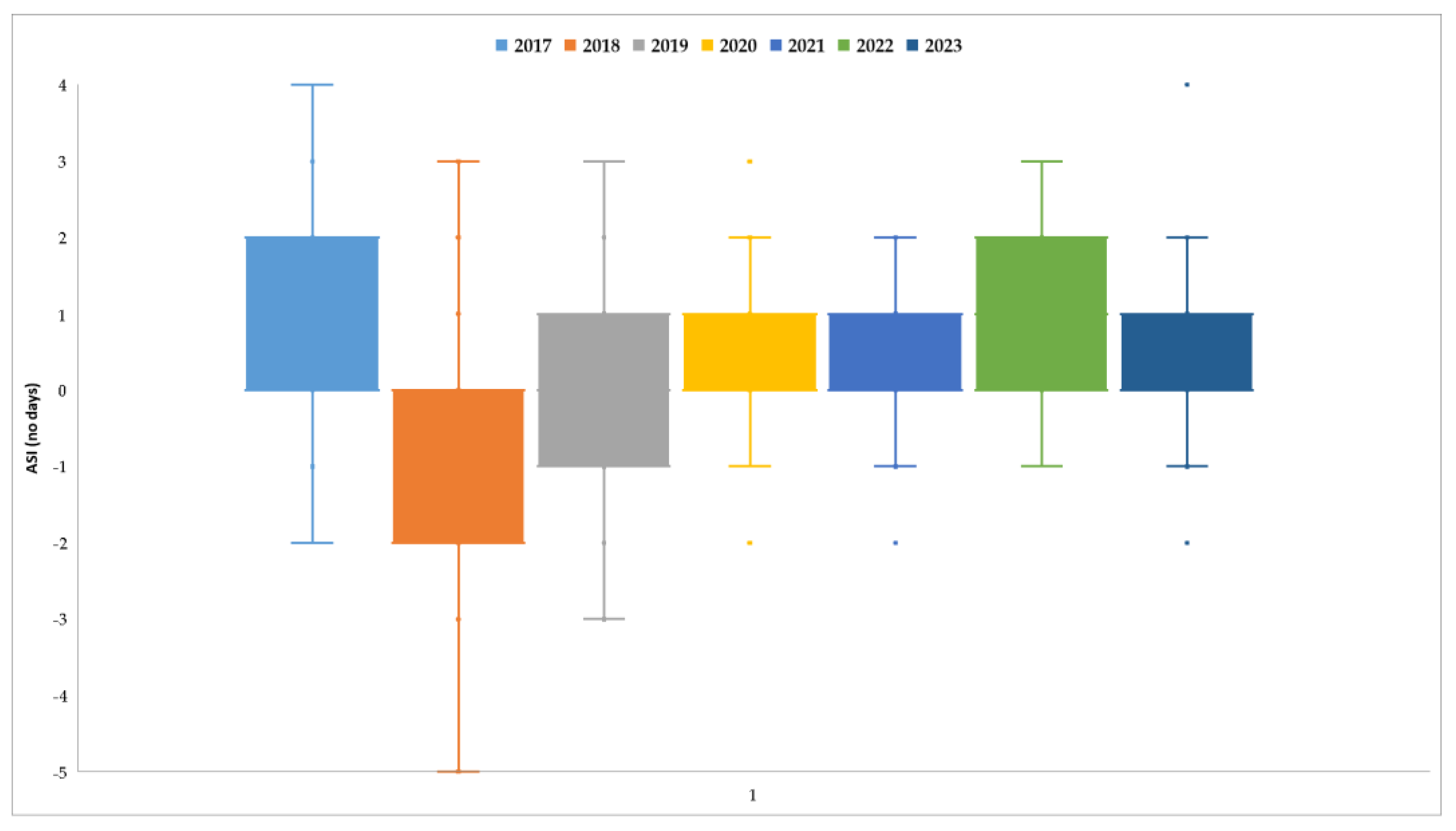
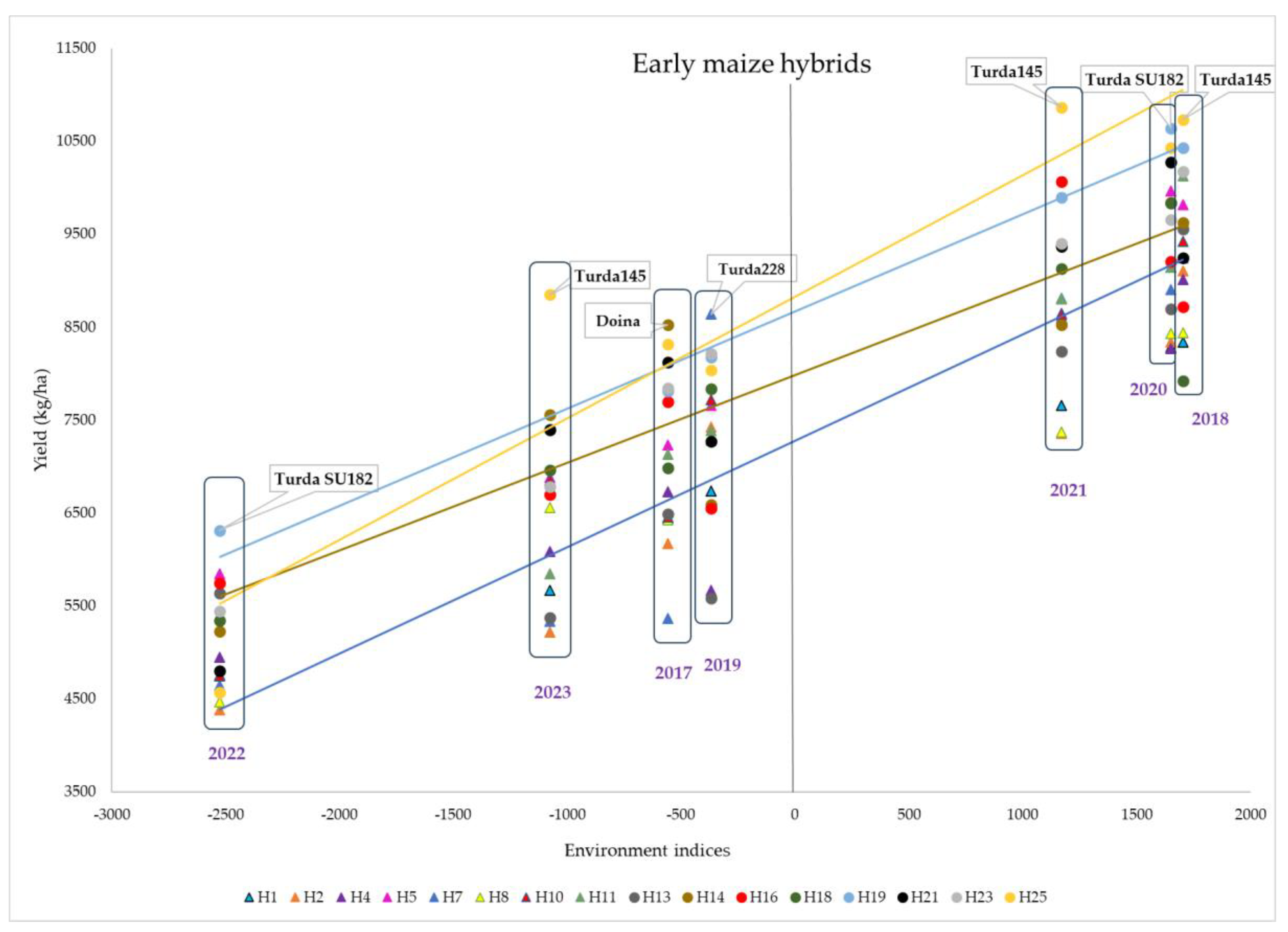

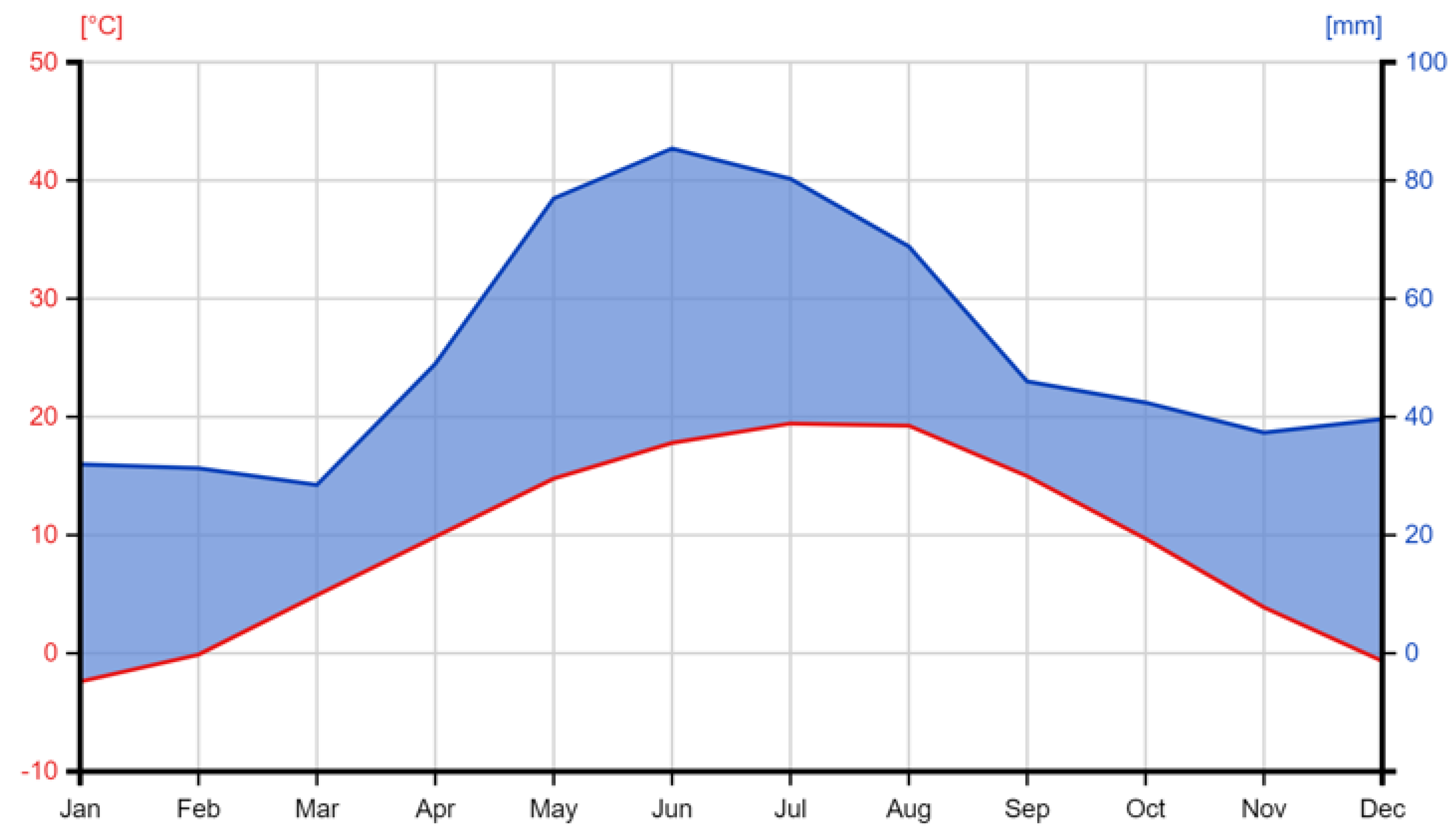
| Year | Maximum Temperature Range (°C) | Number of Rainy Days | Rainfall Sum/Day Range (mm) | Total Sum of Rainfall/Month (mm) |
|---|---|---|---|---|
| 2017 | 20.7–32.3 | 16 | 0.2–24.2 | 110.2 |
| 2018 | 19.5–29.9 | 15 | 0.2–31.5 | 85.7 |
| 2019 | 19.2–34.7 | 10 | 0.2–15.2 | 35.0 |
| 2020 | 21.2–31.2 | 17 | 0.2–12.6 | 86.8 |
| 2021 | 21.7–33.7 | 8 | 0.4–36.5 | 123.1 |
| 2022 | 22.8–38.2 | 8 | 0.2–21.3 | 25.2 |
| 2023 | 26.0–34.2 | 15 | 0.2–39.7 | 85.8 |
| Year | Tmax ≥ .. | Month | ||
|---|---|---|---|---|
| June | July | August | ||
| 2017 | 32 °C | 1 | 2 | 12 |
| 35 °C | - | - | 4 | |
| 2018 | 32 °C | - | - | 1 |
| 35 °C | - | - | - | |
| 2019 | 32 °C | 3 | 3 | 9 |
| 35 °C | - | - | - | |
| 2020 | 32 °C | - | - | 3 |
| 35 °C | - | - | - | |
| 2021 | 32 °C | 3 | 11 | 5 |
| 35 °C | - | - | - | |
| 2022 | 32 °C | 5 | 16 | 10 |
| 35 °C | 1 | 6 | 1 | |
| 2023 | 32 °C | - | 2 | 13 |
| 35 °C | - | - | 2 | |
| Year | Number of Sunshine Hours | Growing Degree Days Index (May + June) | Average Number of Days Between Sowing and Flowering | ||
|---|---|---|---|---|---|
| May | June | July | |||
| 2017 | 193.8 | 253.8 | 225.6 | 497.6 | 66 |
| 2018 | 250.0 | 185.8 | 176.7 | 550.5 | 65 |
| 2019 | 131.1 | 267.7 | 206.0 | 464.9 | 78 |
| 2020 | 173.0 | 167.7 | 206.8 | 387.4 | 84 |
| 2021 | 173.7 | 233.4 | 245.4 | 421.9 | 71 |
| 2022 | 239.8 | 264.0 | 250.5 | 527.7 | 65 |
| 2023 | 180.9 | 174.9 | 244.7 | 436.0 | 69 |
| Experimental Years | Average Yield (kg ha−1) | Difference ± Average (kg ha−1) | |
|---|---|---|---|
| 2017 to 2023 average | 8793 | control | |
| 2017 | 7904 | −889 | 000 |
| 2018 | 10,475 | +1682 | *** |
| 2019 | 8413 | −380 | 0 |
| 2020 | 10,121 | +1328 | *** |
| 2021 | 10,895 | +2102 | *** |
| 2022 | 6209 | −2584 | 000 |
| 2023 | 7433 | −1360 | 000 |
| LSD (p < 0.05) = 302 LSD (p < 0.01) = 423 LSD (p < 0.001) = 598 | |||
| No. | Hybrid Name | Average Yield (kg ha−1) | Difference ± Average (kg ha−1) | |
|---|---|---|---|---|
| Hybrid average | 8793 | control | ||
| 1. | HD115 | 6841 | −1952 | 000 |
| 2. | HS105 | 6857 | −1935 | 000 |
| 3. | HD211 | 7640 | −1152 | 000 |
| 4. | HS105A | 7050 | −1742 | 000 |
| 5. | Turda200 | 8000 | −793 | 000 |
| 6. | Turda215 | 7920 | −873 | 000 |
| 7. | Turda228 | 7278 | −1514 | 000 |
| 8. | Turda100 | 6998 | −1795 | 000 |
| 9. | Turda213 | 7729 | −1064 | 000 |
| 10. | Turda199 | 7566 | −1226 | 000 |
| 11. | Turda160 | 7690 | −1103 | 000 |
| 12. | Turda260 | 8688 | −104 | ns |
| 13. | ELAN | 7081 | −1712 | 000 |
| 14. | Doina | 7983 | −809 | 000 |
| 15. | Saturn | 9339 | +546 | * |
| 16. | Turda200 Plus | 7809 | −983 | 000 |
| 17. | Turda Super | 8344 | −448 | 0 |
| 18. | Turda—SU181 | 7716 | −1077 | 000 |
| 19. | Turda—SU182 | 8667 | −126 | ns |
| 20. | Turda—SU210 | 8157 | −635 | 00 |
| 21. | Turda-Mold188 | 8069 | −724 | 00 |
| 22. | Turda Favorit | 9726 | +933 | *** |
| 23. | Turda 165 | 8216 | −577 | 0 |
| 24. | Turda 201 | 8749 | −43 | ns |
| 25. | Turda 145 | 8829 | +35 | ns |
| 26. | Turda Star | 9469 | +676 | ** |
| 27. | Turda248 | 10,052 | +1259 | *** |
| 28. | Marius TD | 9650 | +857 | *** |
| 29. | Turda332 | 10,760 | +1967 | *** |
| 30. | Turda344 | 11,223 | +2430 | *** |
| 31. | Turda335 | 11,521 | +2727 | *** |
| 32. | Turda2020 | 11,548 | +2755 | *** |
| 33. | Turda380 | 11,688 | +2895 | *** |
| 34. | HST148 | 11,372 | +2579 | *** |
| 35. | SUR18/399 | 11,517 | +2724 | *** |
| LSD (p < 0.05) = 437 LSD (p < 0.01) = 577 LSD (p < 0.001) = 738 | ||||
Disclaimer/Publisher’s Note: The statements, opinions and data contained in all publications are solely those of the individual author(s) and contributor(s) and not of MDPI and/or the editor(s). MDPI and/or the editor(s) disclaim responsibility for any injury to people or property resulting from any ideas, methods, instructions or products referred to in the content. |
© 2024 by the authors. Licensee MDPI, Basel, Switzerland. This article is an open access article distributed under the terms and conditions of the Creative Commons Attribution (CC BY) license (https://creativecommons.org/licenses/by/4.0/).
Share and Cite
Călugăr, R.E.; Varga, A.; Vana, C.D.; Ceclan, L.A.; Racz, I.; Chețan, F.; Șimon, A.; Popa, C.; Tritean, N.; Russu, F.; et al. Influence of Changing Weather on Old and New Maize Hybrids: A Case Study in Romania. Plants 2024, 13, 3322. https://doi.org/10.3390/plants13233322
Călugăr RE, Varga A, Vana CD, Ceclan LA, Racz I, Chețan F, Șimon A, Popa C, Tritean N, Russu F, et al. Influence of Changing Weather on Old and New Maize Hybrids: A Case Study in Romania. Plants. 2024; 13(23):3322. https://doi.org/10.3390/plants13233322
Chicago/Turabian StyleCălugăr, Roxana Elena, Andrei Varga, Carmen Daniela Vana, Loredana Ancuța Ceclan, Ionuț Racz, Felicia Chețan, Alina Șimon, Călin Popa, Nicolae Tritean, Florin Russu, and et al. 2024. "Influence of Changing Weather on Old and New Maize Hybrids: A Case Study in Romania" Plants 13, no. 23: 3322. https://doi.org/10.3390/plants13233322
APA StyleCălugăr, R. E., Varga, A., Vana, C. D., Ceclan, L. A., Racz, I., Chețan, F., Șimon, A., Popa, C., Tritean, N., Russu, F., Ghețe, A. B., & Muntean, L. (2024). Influence of Changing Weather on Old and New Maize Hybrids: A Case Study in Romania. Plants, 13(23), 3322. https://doi.org/10.3390/plants13233322









